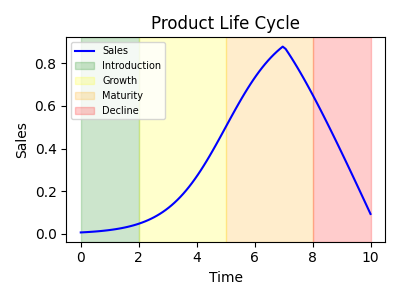The product element of the marketing mix refers to what is being sold – goods or services that satisfy customer needs. Businesses must decide on the features, quality and branding of their products to attract target markets.
Product life cycle
Most products follow a life cycle consisting of distinct stages:
- Development – the product is researched and designed. Sales are zero and costs are high.
- Introduction – the product is launched. Sales grow slowly; heavy promotion may be required.
- Growth – sales rise quickly as awareness increases and profits start to be made.
- Maturity – sales peak and growth slows. Competition may intensify and prices may be reduced.
- Saturation – market becomes fully supplied; sales stagnate.
- Decline – sales and profits fall as consumer interest wanes or new products enter the market.
Understanding the life cycle helps businesses plan marketing strategies such as adjusting pricing or promotion, or introducing extension strategies (e.g. updating the product, entering new markets or changing packaging) to prolong the maturity stage.

Extension strategies
Extension strategies aim to prolong the maturity phase of the product life cycle by refreshing consumer interest. Common approaches include:
- Product improvements: enhancing features or quality, such as upgrading a smartphone’s camera or battery life to encourage repeat purchases.
- New variations: introducing different flavours, sizes or versions of a product (for example, a cereal brand adding a high‑fibre or chocolate variety).
- Repackaging and rebranding: updating the packaging design, colours or logo to make the product look new and appealing (e.g. a confectionery bar in a modern wrapper).
- Price reductions and special promotions: offering discounts, multi‑buy deals or loyalty rewards to attract more buyers.
- Entering new markets: launching the product in new geographic regions or targeting different customer groups, such as marketing a soft drink in an overseas market.
The chart below shows how these strategies can boost sales and delay decline.

Branding and packaging
A brand is a distinctive name, symbol or design that identifies a product and distinguishes it from competitors. Effective branding builds customer loyalty and can command higher prices. Packaging protects the product, provides information and helps create an image. It can be used to attract attention, communicate quality and facilitate use.
Examples and applications
The product life cycle can be seen in many everyday items. When digital cameras first appeared, they were in the development and introduction stages: costly to design and unfamiliar to consumers. As prices fell and quality improved, sales entered a rapid growth phase. Over time, cameras reached maturity as most households owned one, until smartphones with high‑quality cameras caused the market to decline. Some camera manufacturers extended the life cycle by targeting professional photographers or adding innovative features.
Branding and packaging also influence buying decisions. A luxury chocolate bar uses elegant, recyclable packaging and a distinctive logo to position itself as premium and justify a higher price. Supermarket own‑brand products may use simple packaging and a lower price to appeal to value‑conscious customers. Effective product portfolios balance cash cows that generate steady profits (like a long‑established washing powder brand) with stars and question marks that could drive future growth (such as a new plant‑based meat substitute).